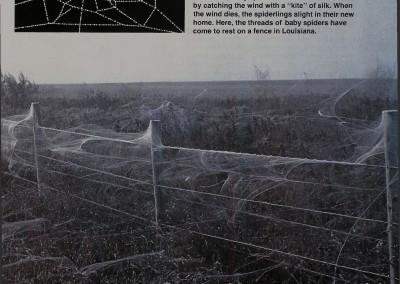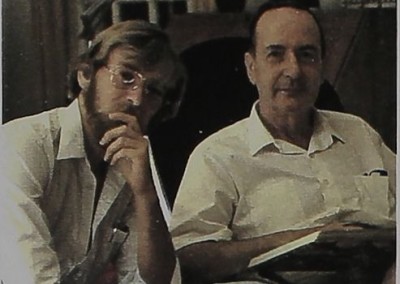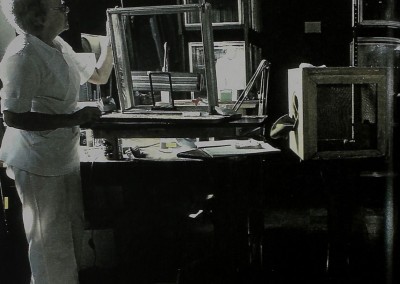Photograph Collection
Read OCR Digitized Article Text
NOTE: This plain text article interpretation has been digitally created by OCR software to estimate the article text, to help both users and search engines find relevant article content. To read the actual article text, view or download the PDF above.
GEOKNOWLEDGE
LIFE ON A SILKEN THREAD
The delicate webs that spiders weave are far more than mere insect traps. Tiny worlds filled with vibration, they are extended organs of touch that allow these nearly blind creatures to flourish.
In autumn, baby spiders set out on their own by catching the wind with a “kite” of silk. When the wind dies, the spiderlings alight in their new home. Here, the threads of baby spiders have come to rest on a fence in Louisiana.
Article by Ben Patrusky Photos by Robert Noonan
The story^^ins in 1948, when young
physician im
pharmacological research at the University of Tübingen in West Germany, was approached by Hans M. Peters, the famed German zoologist. Peters was stumped and needed help. He wanted to make a movie about spider-web construction, but the creatures just wouldn’t cooperate. The species He worked with wpve their-cartwheel webs daily at about four o’clock in the morning, when there wasn’t sufficient light for filming. Peters shunned the use of artificial light for fear of disrupting normal web manufacture.
Peters hoped Witt could come up with a drug that would induce the spiders to shift their web-building activity to a later, more cinematically suitable time. Witt tried a variety of agents, from stimulants to sedatives. None of the drugs worked—but they did provoke some startling behavioral changes, causing the spiders to weave eerily deranged webs. Discouraged, Peters abandoned his film project. But now Witt had become intrigued. He saw a way in which spider webs could help him in his efforts to understand the effects of mind-altering drugs on human behavior. In Witt’s view, the webs offered a powerful analogue of mental aberration and provided a new tool with which to screen chemicals for hallucinogenic potèntiaL Witt’s demonstration of the weird ways in which LSD, caffeine, marijuana and other agents distort web architecture gained worldwide headlines. But his fateful encounter with Peters had a more far-reaching effect on his life: it sparked what was to become his lifelong affair with these creatures. “I love spiders,” Witt says simply.
Witt’s addiction to spiders did not, however, divert him from his interest in clinical medicine and human disorders. For 15 years, until his recent re-
Spider expert Peter Witt shows photographer Robert Noonan il* lustrations of various webs
(above); each species spins a different type. Some examples of the most common designs appear in the insets opposite: a close-up of moth scales and wing bits caught in the orb web of a cross-spider; a funnel web built by a grass spider; and the stabilimentum web of a crossweb spider. Below the insets: a sheet web covered with dew.
tirement, Witt managed to combine both pursuits as chief of research at the North Carolina Department of Mental Health in Raleigh.
Witt’s unusual introduction to spiders immediately placed him in the vanguard of arachnological research. Traditionally, spider scientists had for the most part confined themselves to taxonomy—the business of pinning specimens under a microscope and identifying and classifying creatures according to morphology (size and color), family, genus and species. Trifling importance was attached to inquiry into spider dynamics, into how they live and what they do. But that is precisely where Witt’s interest lay—in behavior, as expressed in that most extraordinary activity of all, the manufacture of the web. Through the years, Witt and a coterie of other scientists have succeeded in demystifying the spider by unraveling many long-standing secrets about this superlative, bigbrained form of invertebrate life. Not surprisingly, neurobiologists (scientists concerned with how the brain
processes information) have also begun to take a shine to these silk-spinning builders, using the web as a kind of “road map” linking nervous-system function to behavior.
Before his Witt allowed
me into his wondrously cluttered laboratory and began to unfold the dazzling story of life on a silken thread.
Not all spiders spin webs, Witt explained. In fact, of-the approximately 30,000 species identified in the world so far, about half don’t. These spiders survive as prowlers, va
grant hunters of insectprey. One such is the tarantula, the most primitive spider of>ai|il *
For web weavers, however, the structure is more than just an insect snare. For these architects-in-silk, the web is their window on the world, their primary vehicle of communication. Witt invokes the wisdom of the German philosopher Schopenhauer to explain the web’s relationship to the survival of the spider. Schopenhauer argued that our understanding of the world is formed by the organs of perception. For humans, it’s a predominantly visual world; for the nearly blind web-building spider, it’s a world filled with touch and vibration. Not only do the signals transmitted through the silken threads reveal information about the heft and location of trapped prey but they also play a delicate role in the precarious business of spider courtship and mating. The web, in effect an extended organ of touch, , is the key to the spider’s well-being and social life. “The blind spider, without a web, is all but helpless,” says Witt. “He is unable to catch or even to identify prey without vibration cues, and his feet, adapted for hanging on threads, slip on smooth surfaces. ”
Experiments have shown that even an extremely hungry web-building spider will not touch a fly that passes di-rectf^ under its mouth if the fly’s ^mpvement|s> are not transmitted through the web. Mating, top, is impossible without a silken intermediary.
The silk used for making webs ema-
94 GEO
The eight pictures below were taken in the laboratory of Robert Noonan. Moving from left to right, the first six photos cover a period of one hour and ten minutes—from the time this Araneus diadema-
tus began building her orb web to the time she returned to the center, or hub, to wait for her first meal. The last two pictures show the spider attacking a butterfly and then carrying it back to the hub. The A diadematus builds a new web each morning. The spider starts by
suspending a bridge from two anchor points; she then spins a vertical thread from the center of the bridge. That thread becomes the third leg of a Y-shaped structure. The intersection of these three legs is the hub of
the web. Once the hub is completed, the spider spins from 30 to 40 radial threads. To give the radii—or signal threads—temporary stability, the spider puts up a makeshift spiral. Then, working inward, she lays the permanent spiral. Unlike the signal threads,
the permanent spiral is made of a sticky silk necessary for trapping food. Back in the center, the spider waits for a meal, her eight legs grasping the radii. When the butterfly hits
the web, it creates vibrations, which the spider feels through the radial threads. The spider darts from the hub and paralyzes her prey with poisonous fangs. A. diadematus then swathes her prey in silk and carries it back to the hub to eat.
SPIDERWEBS
nates from spinnerets, fingerlike structures on the spider’s abdomen. Originally manufactured äs a liquid protein in a special gland, the silk hardens on exposure to air to form thread through a process that still defies explanation or duplication by even the best textile or industrial chemists. Actually all spiders, not just web builders, manufacture and deploy silk-^in some cases as many as seven different kinds, of varying thickness, strength and elasticity. One kind of silk is used for the production of a “dragline” that provides the spider with transportation or an emergency escape route. Other silks may be used for wrapping prey, lining a burrow or shelter, “skydiving” to a new location, enclosing egg sacs in watertight cocoons or fastening web frames to anchorages. The web itself calls for a variety of threads. The wheellike orb web, for instance, features dry, strong silk for the s||p porting structure and the message-transmitting threads, and thin, sticky silk for trapping. Some species of spider also have an appendage called a cribellum for combing the emerging silk into woolly, barbed-wirelike entangling snarls.
Each species of web-building spider weaves a different kind of web, employing every trapping principle from simple trip wires to complex spring traps. But generally the architecture fits one of three basic blueprints: the sheet web (a two-dimensional structure usually built near the ground and showing no symmetry, the dense tangle of threads crossing one another in helter-skelter fashion); the space web (a three-dimensional, multitiered arrangement); the geometric orb (the familiar, nearly invisible aerial net built to snare flying insects).
In evolutionary terms, says Witt, nature “really went out on a limb” when it created web-building spiders—much as it did when it gave rise to humans. “Both forms of life repre-
98 SB
sent high degrees of specialization. We and they have survived in a caricatured way. Mature gaveyifs an extremely elaborate brain, which is instrumental in our survival. . Webbuilding spiders also have a monstrous brain in relation to their total body size, probably the most highly developed brain of all invertebrates. In spiders, that brain power gô”Cs toward the elaboration of another form of evolutionary extremism—web building.”
As architects, spiders are a medium for the message locked in their genes, the units of heredity. The ability to build webs is inherited, the species blueprint passed from one generation to the next. Newborn spiderlings don’t get to meet their parents; there is no generation-to-generation teaching of web spinning. Most orb weavers are seasonal spiders: they live for one
summer, lay their eggs and die in autumn. To survive, the newborn spi-derling must be able to spin a perfect web from the outset. And that it does. Says Witt: “We have measured the newborn’s very first complete orb web, and there’s nothing inferior about it. The inherited program has been laid down in the little one’s central nervous
It’s a programhlvir t^ ten, as is evidenced by a series of experiments in which spiderlings were reared in narrow tubes that made web building impossible. Since they had no means of capturing prey, the spiders had to be fed directly by hand. Released from their tubular prisons as adults a few months later, the spiders soon set about weaving webs that were in no way different from those constructed by littermates allowed to build and use webs daily. Feeding,
Peter Witt’s laboratory at the North Carolina Department of Mental Health in Raleigh is home to more than 100 spiders, which go about their daily business under the scrutiny of Witt and his staff. Here, assistant Mabel Scarboro takes a close look into a spider cage.
however, proved a different matter.
In another experiment, tube-reared spiders that were placed in prespun webs seemed to have forgotten the main purpose of the web; they ignored prey that had become ensnared in their webs and still had to be fed directly. Unlike web building itself, the business of fly catching seems to require early life experience and practice before it becomes a natural part of the spider’s survival repertoire.
Preprogrammed though web build
ing is, there nonetheless remains some room for adjustment in the genetic instructions. “Otherwise,” says Witt, “we’d see a great deal of nonsense being woven, lots of functionless web making. But that doesn’t happen. There is something akin to assessment going on. ” Consider, for instance, what happens when a spider is taken out of its web midway through construction, drained of much of its remaining silk supply and then put back into the incomplete structure. At first the spider immediately picks up where it left off. It then adapts to its own silk depletion by finishing the web using wider-than-normal spacing in the spirals. When hung with weights to make it more massive, the spider responds by spinning thicker web strands to support its increased bulk. To compensate for the run on its silk supply, the spider still produces a full-size web but one with fewer radiais and fewer spiral turns.
Witt has also “spiked” a spider’s meal with drugs that spur an increase in silk production. The spider adjusted; it spun a bigger web. “Orb web-bers seem to plan ahead,” says Witt, “so that they neither run out of silk before the job is done nor have any measurable amount left over in their silk glands.”
Perhaps the most dramatic evidence of the ability to meet silk demand according to available supply comes from starvation studies, which also reveal the extreme survival value of the web. When deprived of food, the spider does not weave a smaller web to conserve its protein resources. Neither does it simply build a larger web in order to capture more prey. Instead, the spider continues to build webs that are exactly the same size as the ones it built before being deprived of food. To obtain the necessary protein for silk, the spider uses that contained in its own body—in the process suffering a dramatic weight loss. Even when it has shrunk to half of its original size, it still spins a full-size web—but, again, with a wider mesh so that less
thread covers the same area. After six full weeks of starvation, the spider will finally begin to spin smaller webs.
Each species of orb webber weaves its own distinct design. But even among members of the same litter— let alone the same species—no two webs are alike. “Each web is unique, ” says Witt, “as distinctive as a person’s face, signature or fingerprint.” Witt didn’t come by this knowledge easily. It has taken nearly a decade of painstaking analysis of web construction. Witt eventually became so adept at identifying the kind of webs each of his spiders was weaving that he could tell at a glance whether his assistants had moved the cages around in his laboratory. “The more you look, the more you see, ” says Witt.
For the male spider, the act of mating is an enterprise fraught with peril. Spiders lead what is perhaps the most solitary existence of all creatures. Anything that touches the web becomes fair game. And so, species by species, males have developed an astonishing number of ploys for wooing without being eaten in the process. They range from disarming the female directly by wrapping her in silk to attaching a “mating thread” to the female’s web. The male plucks on the thread, presumably to signal his intentions, and the vibrations are transmitted by the web radiais to the object of his affections. If the female reacts menacingly, the male cuts loose, using the mating thread as a getaway line.
In the species Herennia omatissma, the males lose their reproductive organs during mating. The resulting eunuchs become web sentries, preventing fertile males from approaching. Often mature females are far bigger than their suitors. This, too, may have survival value, in that it makes the males unappetizing to the female accustomed to larger prey. Sometimes the male comes bearing gifts—an insect wrapped in silk, for example. But nothing in spider repro-(Continued on page 116)
GEO 99






